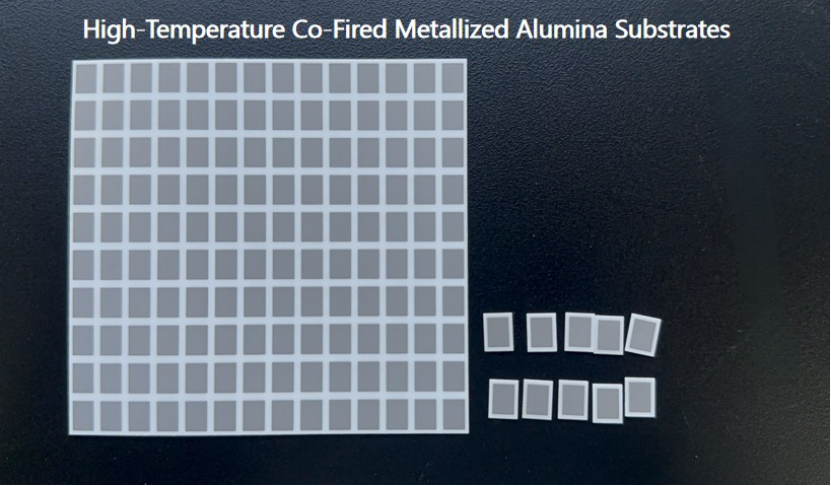
The rapid growth of power electronics in sectors from consumer devices to military equipment has increased the need for efficient packaging solutions. Alumina substrates are widely used as substrates due to their excellent dielectric constant, high dielectric strength, low dielectric loss, good thermal stability, and high mechanical strength.
Alumina substrates are ceramic platforms made from aluminum oxide (Al₂O₃). They are valued in electronics for their thermal conductivity, electrical insulation, mechanical strength, and chemical stability. These substrates are often used as a base for mounting electronic components due to their ability to withstand high temperatures and provide a reliable electrical interface. Metallization involves applying a metal layer to these non-conductive ceramics, enabling strong electrical and mechanical bonding with metal parts that is essential for device reliability. However, since alumina cannot be directly welded to metals, metallization is essential to bond ceramic and metal layers effectively.
This research aims to develop a method for preparing metallized alumina substrates using tape casting and high-temperature co-firing processes. The study explores the effects of powder characteristics, the tape casting process, and co-firing conditions on the structure and performance of the metallized substrates. The primary goal is to produce composite materials with low warpage and high bonding strength between the metal and ceramic layers.
1. Alumina Powder: High-purity alumina powder with a uniform particle size is selected, typically with a purity of over 95%. The specific purity and particle size distribution are determined based on the substrate's performance requirements.
2. Metal Slurry: Common metal slurries include silver and copper, composed of metal powder, an organic carrier, and additives. The metal powder's particle size should match the alumina powder's size. The organic carrier influences the slurry's rheology and printing performance, while additives enhance the slurry's overall performance.
Alumina powder is mixed with an organic binder,a plasticizer, and a solvent to form a ceramic blank with good plasticity. This mixture is then processed using tape casting to create a green ceramic tape of a specific thickness, usually ranging from tens to hundreds of microns.
Screen printing technology is employed to print the metal slurry onto the green ceramic tape, forming the desired circuit and electrode patterns.
The printed green tapes are stacked according to the designed layer count and order, ensuring precise alignment between layers. After stacking, the tapes are hot-pressed to form a laminated body with sufficient strength. Parameters such as hot-pressing temperature, pressure, and time are optimized based on the green tape's material and thickness.
The laminated body undergoes debinding and is then placed in a high-temperature furnace for sintering. At high temperatures, the alumina powder densifies and sinters, while the metal slurry co-fires with the alumina to form a robust metallization layer. The sintering temperature typically ranges from 1500 to 1600°C in a specific protective atmosphere.
The sintered substrate is subjected to mechanical processing, such as cutting, grinding, and polishing, to achieve the required dimensional accuracy and surface flatness. Surface treatments like electroplating and chemical plating may be applied to enhance the metallization layer's performance and weldability.
Ball mill, degassing machine, casting machine, hot cutting machine, screen printing machine, isostatic press, debinding furnace, and sintering furnace.
Laser particle size analyzer, Scanning electron microscope, Bending strength tester, and welding tensile tester.
Raw Material Purity: High purity of alumina powder and metal slurry is crucial. Impurities can degrade substrate performance, reducing insulation and increasing dielectric loss.
Raw Material Particle Size: Matching and uniform distribution of alumina and metal slurry particle sizes are essential to ensure effective tape casting and co-firing, preventing uneven substrate density and poor metallization layer bonding.
Raw Tape Composition Ratio: The ratio of organic binder, plasticizer, and solvent must be optimized to ensure the blank's plasticity and the raw tape's flexibility and strength, preventing breakage and delamination during processing.
Casting Parameters: Casting speed and scraper height must be strictly controlled to ensure uniform thickness of the green ceramic tape, preventing inconsistent substrate thickness and performance.
Printing Accuracy: Screen printing must produce accurate and clear metal paste patterns to avoid issues like blurred or broken lines, which can affect circuit performance.
Lamination Alignment Accuracy: Accurate alignment of green ceramic tape layers during lamination is vital to prevent circuit pattern deviation and abnormal electrical performance.
Hot Pressing Parameters: Hot-pressing temperature, pressure, and time must be carefully controlled to ensure tight bonding of the green ceramic tape layers without causing deformation or metal paste diffusion.
Temperature Control: Precise control of the sintering temperature is essential to ensure proper alumina densification and metallization layer quality, preventing issues like low substrate strength and metallization layer cracking.
Atmosphere Selection: The choice of sintering atmosphere must be appropriate for the metal slurry type. For example, copper slurry typically requires a reducing atmosphere to prevent metal oxidation.
Surface Treatment: Uniform and complete surface treatment is necessary to enhance the metallization layer's corrosion resistance, solderability, and electrical properties.
Tape Casting of Alumina Substrate: The use of tape casting for alumina substrate preparation offers high production efficiency and scalability, particularly for substrates thinner than 1.0 mm.
High-Temperature Co-Firing Process: The co-firing process of raw ceramic sheets significantly improves machining efficiency, reducing production time and costs.
The preparation of metallized alumina substrates through tape casting and high-temperature co-firing processes represents a significant advancement in the field of power electronics. By addressing key issues in raw material selection, processing parameters, and post-processing techniques, this method ensures the production of high-performance substrates with low warpage and strong metal-ceramic bonding. These innovations contribute to the development and application of power electronic devices, offering enhanced reliability and efficiency in various electronic applications.
In copper wire bonding, inert gas is essential to block oxygen from the atmosphere and prevent oxida...
READ FULLWire bonding machines are critical tools in the semiconductor packaging process, and the choice of E...
READ FULL